The Impact of Weight Distribution in Heavy Battery Electric Vehicles on Pavement Performance: A Preliminary Study
Abstract
1. Introduction
- Weight distribution: The truck’s chassis normally houses the battery pack, which may cause a shift in the distribution of weight and impact how the load is distributed on the axles.
- Center of gravity: The battery pack’s location may also change the truck’s center of gravity, which may have an impact on handling and stability [18].
- Axle loads: The truck’s overall weight may rise due to the weight of the battery pack, which would put more strain on the suspension and axles.
- Load distribution: Adding an electric battery may also alter how the weight is distributed between the front and back axles, necessitating modifications to the suspension system in order to preserve ideal load distribution.
2. Aim and Objectives
- To establish a full pavement model comprising material properties, layer stratigraphy, and axle load determination. In terms of the model’s stratigraphy, the aim was to cover cases ranging from secondary roadways to heavy-duty motorways. Since the analysis was theoretical, the robustness of all the assumptions needed to be ensured too.
- To quantify flexible pavement responses because of ICEVs and different cases of HBEVs. Response calculations were performed with the well-known 3D-Move Analysis (version 2.1) developed in the University of Nevada, Reno [21].
- To estimate pavement performance in terms of the fatigue damage potential, which is crucial for maintenance and rehabilitation decision-making. Accordingly, relative damage was calculated based on Miner’s law and the MEPDG fatigue law was used for the estimation of the allowable traffic repetitions until failure is reached [22].
- To additionally evaluate pavement response and performance indicators with statistical methods (e.g., t-tests, descriptive statistics).
3. Research Methodology
3.1. Typical Pavement Section and Materials
3.2. Loading Considerations
3.3. Analysis Framework
- and ; and are binder and air-void contents (by mixture volume) with default values of 4.5% and 7.6%, respectively, considered in the 3D-Move software and assumed herein too.
- is a factor dependent on the thickness of the asphalt layers ( in inches). Its use is expected to increase the predicted pavement fatigue life (transfer function). Ch is defined in Equation (3). The parameters a, b, c, and d vary depending on the failure mode, i.e., bottom–up or top–down cracking. For the former, a, b, c, and d take the values of 0.000398, 0.003602, 11.02, and 3.49, respectively.
- : Local or mixture-specific field calibration constants; for the global calibration effort, these constants were set to 1.0. In the absence of local field calibration, unity values are commonly utilized in similar studies, e.g., [29].
- : Global field calibration constants. NCHRP 1-37A proposes the values of 1, 3.9492, and 1.281 for bottom–up cracking prediction [22].
- , : Tensile strain (m/m) at the depth for bottom–up cracking prediction and the dynamic modulus of AC (expressed in psi), respectively.
- : The predicted traffic repetitions per axle load. In the absence of specific traffic data, , and were all set equal to 1, and the calculated damage corresponded to the relative damage of each truck or else the “quasi-damage” caused from just one passage of the considered truck. The term “relative damage” is, thus, used solely for comparative purposes.
- : The allowable traffic repetitions per axle load (i.e., as calculated from Equation (2)).
4. Results
5. Discussion, Limitations, and Opportunities
- First, a theoretical framework without field calibration or validation was used for the analysis. In real-scale conditions, pavements are exposed to additional environmental and weather effects apart from traffic loading. Temperature variations, moisture conditions, and rainfall events can drastically affect the evolution of pavement damage; future pavement performance monitoring of pilot test sections is necessary for an improved understanding and validation of the coupled impacts of HBEVs. In the meantime, long-term aspects like material aging, fatigue accumulation, environmental exposure, etc., can have a significant influence on performance and, thus, should be more systematically studied in the near future.
- Second, rather than using a fully coupled thermal–mechanical–viscoelastic model, modulus variation was used to indirectly reflect temperature effects. However, this approach ignored the dynamic nature of loading (i.e., temperature- and frequency-dependent) and the temporary effects of braking and acceleration forces that could alter pavement damage evolution.
- Third, the vehicle layouts did not include regenerative braking or acceleration forces, which may also have an additional impact on pavement wear patterns [1]. These are inherently related to HBEVs and thus should be jointly studied in the future.
- Finally, only one truck type with a unique axle load configuration and a single value of GVW was considered. Variable GVW depends on non-pavement-related aspects, i.e., transportation logistics, route planning, etc. Beyond detecting variations in pavement performance (as in the present study), extension of the response analysis with variable GVW, truck types, and axle configurations could offer an optimized scheduling of vehicle route planning in favor of pavement performance and optimal road asset condition.
6. Conclusions
- The study demonstrates that battery placement and weight distribution in HDEVs significantly affect pavement fatigue performance. Concentrating the battery mass at the steering axle produced the most unfavorable outcome, with up to ~180–200% higher fatigue damage, while placement at the rear tractor axles with dual tires resulted in negligible differences compared to conventional trucks.
- Pavement response is sensitive not only to gross vehicle weight but also to axle load distribution and tire configuration. Critical influencing factors include asphalt concrete stiffness, which is temperature-dependent, pavement layer stratigraphy, and axle geometry.
- Concentrated battery loads over specific axles can accelerate bottom–up cracking. This highlights the importance of accounting for infrastructure impacts—both direct effects on traffic operations and safety [34] and, further, indirect implications for vehicle design and fleet logistics.
- While the analysis relied on multilayer elastic theory and a simplified dataset, the results provide preliminary but essential scientific evidence that battery placement is an infrastructure-relevant design variable for HDEVs.
Funding
Data Availability Statement
Conflicts of Interest
References
- Zhou, Q.; Ramakrishnan, A.; Fakhreddine, M.; Okte, E.; Al-Qadi, I.L. Impacts of heavy-duty electric trucks on flexible pavements. Int. J. Pavement Eng. 2024, 25, 2361087. [Google Scholar] [CrossRef]
- Fam, A.; Fam, S. Review of the US 2050 long term strategy to reach net zero carbon emissions. Energy Rep. 2024, 12, 845–860. [Google Scholar] [CrossRef]
- Yeo, Y.; Yoo, T.; Yoo, S.; Ahn, Y.-H. 2050 net-zero scenarios and well-to-wheel greenhouse gas emissions assessment of South Korea’s Road sector. J. Clean. Prod. 2025, 492, 114809. [Google Scholar] [CrossRef]
- Moultak, M.; Lutsey, N.; Hall, D. Transitioning to Zero-Emission Heavy-Duty Freight Vehicles; The International Council on Clean Transportation: Washington, DC, USA, 2017. [Google Scholar]
- Karlsson, J.; Grauers, A. Case Study of Cost-Effective Electrification of Long-Distance Line-Haul Trucks. Energies 2023, 16, 2793. [Google Scholar] [CrossRef]
- Zhang, W.; Han, W.; Jiang, W.; Cui, T.; Wang, S.; Yang, F.; Wei, J. Fatigue Damage in Asphalt Pavement Based on Axle Load Spectrum and Seasonal Temperature. Coatings 2024, 14, 882. [Google Scholar] [CrossRef]
- Maggiore, C.; Airey, G.; Marsac, P. A dissipated energy comparison to evaluate fatigue resistance using 2-point bending. J. Traffic Transp. Eng. (Engl. Ed.) 2014, 1, 49–54. [Google Scholar] [CrossRef][Green Version]
- Svilar, M.; Peško, I.; Šešlija, M. Model for Estimating the Modulus of Elasticity of Asphalt Layers Using Machine Learning. Appl. Sci. 2022, 12, 10536. [Google Scholar] [CrossRef]
- Marecos, V.; Solla, M.; Fontul, S.; Antunes, V. Assessing the pavement subgrade by combining different non-destructive methods. Constr. Build. Mater. 2017, 135, 76–85. [Google Scholar] [CrossRef]
- Chabot, A.; Chupin, O.; Deloffre, L.; Duhamel, D. ViscoRoute 2.0: A tool for the simulation of moving load effects on asphalt pavement. Road Mater. Pavement Des. 2010, 11, 227–250. [Google Scholar] [CrossRef]
- Loizos, A.; Spiliopoulos, K.; Cliatt, B.; Gkyrtis, K. Structural pavement responses using nonlinear finite element analysis of unbound materials. In Proceedings of the 10th International Conference on Bearing Capacity of Roads, Railways and Airfields (BCRRA), Athens, Greece, 28–30 June 2017; pp. 1343–1350. [Google Scholar]
- Li, Y.; Xuan, W.; Rahman, A.; Ding, H.; Yusupov, B. Effects of Geometry and Loading Mode on the Stress State in Asphalt Mixture Cracking Tests. Materials 2022, 15, 1559. [Google Scholar] [CrossRef] [PubMed]
- Wang, H.; Al-Qadi, I.L. Evaluation of Surface-Related Pavement Damage due to Tire Braking. Road Mater. Pavement Des. 2010, 11, 101–121. [Google Scholar] [CrossRef]
- Misaghi, S.; Tirado, C.; Nazarian, S.; Carasco, C. Impact of pavement roughness and suspension systems on vehicle dynamic loads on flexible pavements. Transp. Eng. 2021, 3, 100045. [Google Scholar] [CrossRef]
- Martinez-Boggio, S.; Monsalve-Serrano, J.; García, A.; Curto-Risso, P. High Degree of Electrification in Heavy-Duty Vehicles. Energies 2023, 16, 3565. [Google Scholar] [CrossRef]
- Hernandez, J.; Jayme, A.; Cardenas Huamam, J.J.; Al-Qadi, I.L. Effect of Heavy-Duty Electric Vehicles on Tire–Pavement Contact Forces. J. Eng. Mech. 2025, 151, 04024104. [Google Scholar] [CrossRef]
- Jayme, A.; Hernandez, J.; Al-Qadi, I.L.; Cardenas, J.J.; Hafeez, M.; Villamil, W. Impact of Heavy Commercial Electric Vehicles on Flexible Pavements; Report No. FHWA-ICT-25-003; Illinois Center for Transportation: Rantoul, IL, USA, 2025. [Google Scholar] [CrossRef]
- Previati, G.; Mastinu, G.; Gobbi, M. Mass, Centre of Gravity Location and Inertia Tensor of Electric Vehicles: Measured Data for Accurate Accident Reconstruction. World Electr. Veh. J. 2024, 15, 266. [Google Scholar] [CrossRef]
- Suriyamoorthy, S.; Gupta, S.; Kumar, D.P.; Subramanian, S.C. Analysis of hub motor configuration and battery placement on ride comfort of electric trucks. In Proceedings of the 2019 IEEE Vehicle Power and Propulsion Conference (VPPC), Hanoi, Vietnam, 14–17 October 2019; pp. 1–6. [Google Scholar] [CrossRef]
- Arora, S.; Abkenar, A.T.; Jayasinghe, S.G.; Tammi, K. Heavy-Duty Electric Vehicles, from Concept to Reality; Elsevier: Amsterdam, The Netherlands, 2021. [Google Scholar] [CrossRef]
- Siddhartan, R.; Krishnamenon, N.; Sebaaly, P. Pavement Response Evaluation Using Finite-Layer Approach. Transp. Res. Rec. 2000, 1709, 43–49. [Google Scholar] [CrossRef]
- NCHRP. Final Report: Guide for Mechanistic-Empirical Design of New and Rehabilitated Pavement Structures, NCHRP 1-37A Project; Transportation Research Board National Council: Washington, DC, USA, 2004. [Google Scholar]
- Gkyrtis, K. Pavement Analysis with the Consideration of Unbound Granular Material Nonlinearity. Designs 2023, 7, 142. [Google Scholar] [CrossRef]
- Powell, W.D.; Potter, J.F.; Mayhew, H.C.; Nunn, M.E. The Structural Design of Bituminous Roads; Transport and Road Research Laboratory (TRRL) Report 1115; TRRL: Berkshire, UK, 1984. [Google Scholar]
- Alnadish, A.M.; Aman, M.Y.; Katman, H.Y.B.; Ibrahim, M.R. Influence of the Long-Term Oven Aging on the Performance of the Reinforced Asphalt Mixtures. Coatings 2020, 10, 953. [Google Scholar] [CrossRef]
- Theyse, H.L.; De Beer, M.; Maina, J.W.; Kannemeyer, L. Interim revision of the south African mechanistic-empirical pavement design method for flexible pavements. In Proceedings of the 10th Conference on Asphalt Pavements for Southern Africa (CAPSA), KwaZulu-Natal, South Africa, 11–14 September 2011. [Google Scholar]
- Rahman, S.; Ahmed, A.; Erlingsson, S. Responses of a thin flexible pavement loaded with tires of various dimensions and configurations. Road Mater. Pavement Des. 2025, 26, 680–699. [Google Scholar] [CrossRef]
- Khan, S.; Cotter, C.; Sholar, G.A.; Tia, M. Comparison of wide base single tyre and dual tyre with different factors using heavy vehicle simulator. Road Mater. Pavement Des. 2024. [Google Scholar] [CrossRef]
- Gkyrtis, K.; Plati, C.; Loizos, A. Mechanistic Analysis of Asphalt Pavements in Support of Pavement Preservation Decision-Making. Infrastructures 2022, 7, 61. [Google Scholar] [CrossRef]
- Marecos, V.; Fontul, S.; Antunes, M.L.; Solla, M. Evaluation of a highway pavement using non-destructive tests: Falling Weight Deflectometer and Ground Penetrating Radar. Constr. Build. Mater. 2017, 154, 1164–1172. [Google Scholar] [CrossRef]
- Crook, A.L.; Montgomery, S.R.; Guthrie, W.S. Use of falling weight deflectometer data for network-level flexible pavement management. Transp. Res. Rec. 2012, 2304, 75–85. [Google Scholar] [CrossRef]
- Plati, C.; Gkyrtis, K.; Loizos, A. Integrating non-destructive testing data to produce asphalt pavement critical strains. Nondestruct. Test. Eval. 2021, 36, 546–570. [Google Scholar] [CrossRef]
- Gkyrtis, K.; Armeni, A.; Loizos, A. A mechanistic perspective for airfield pavements evaluation focusing on the asphalt layers’ behaviour. Int. J. Pavement Eng. 2022, 23, 5087–5100. [Google Scholar] [CrossRef]
- Gkyrtis, K.; Pomoni, M. Use of Historical Road Incident Data for the Assessment of Road Redesign Potential. Designs 2024, 8, 88. [Google Scholar] [CrossRef]



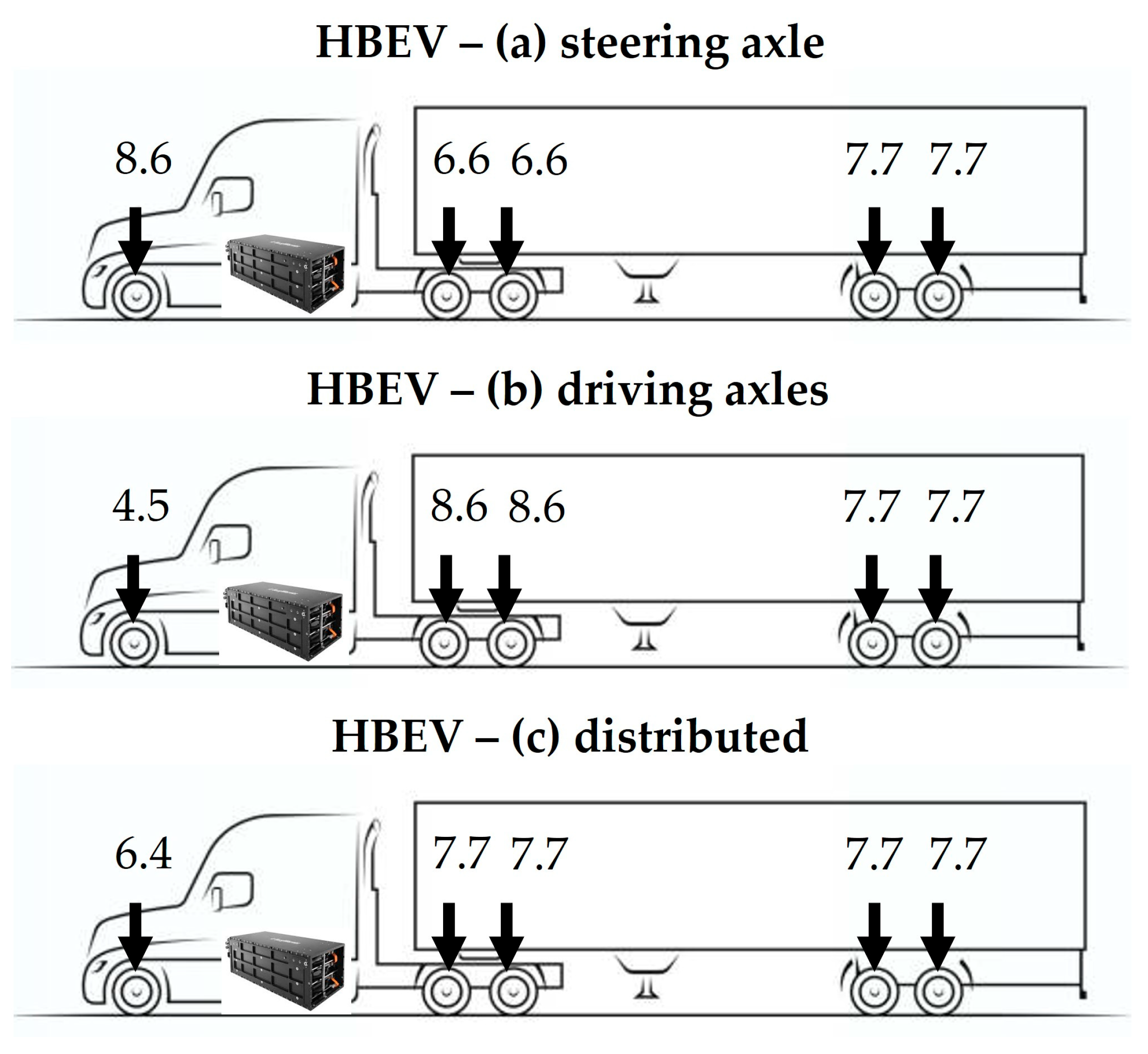

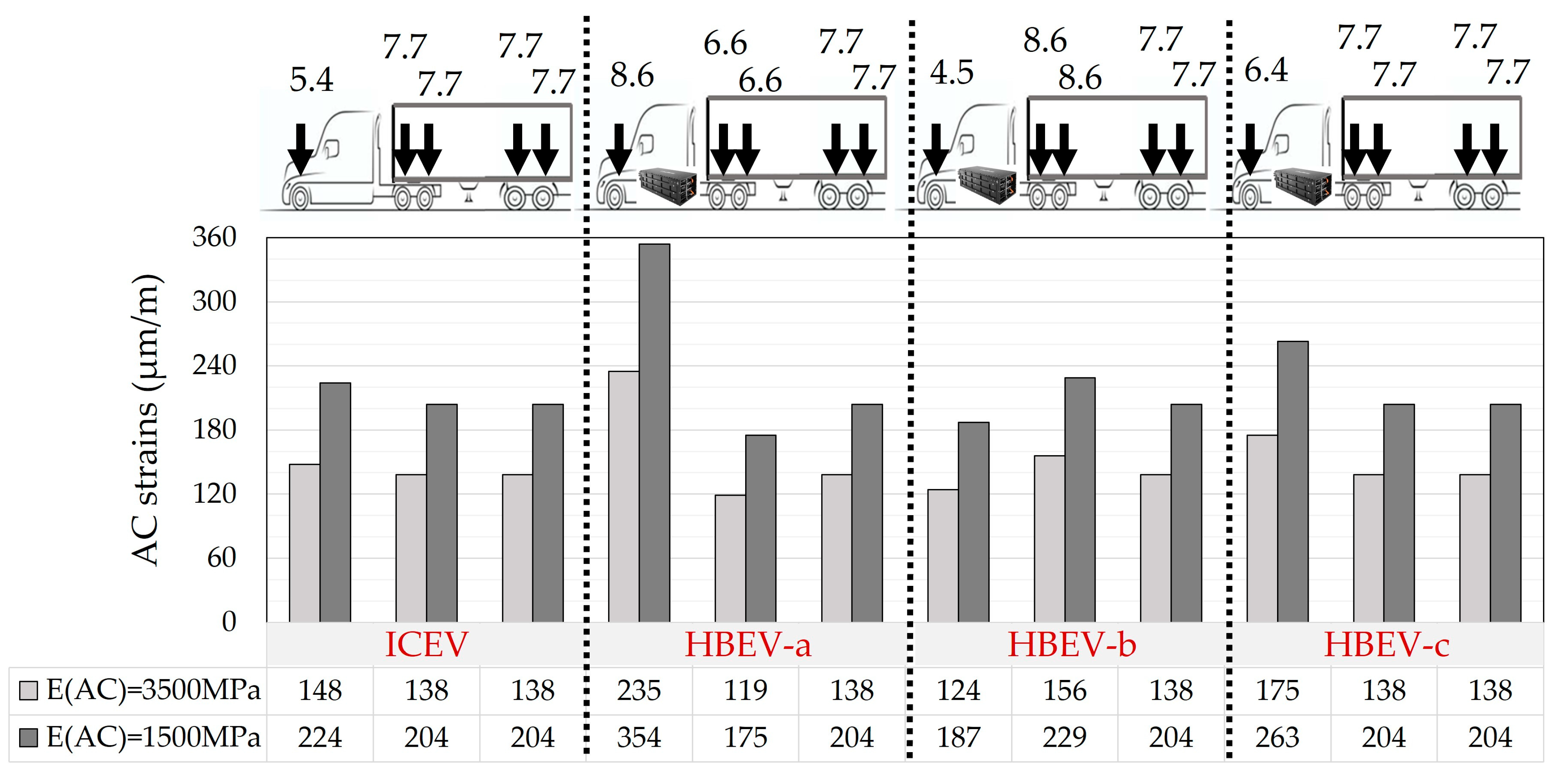
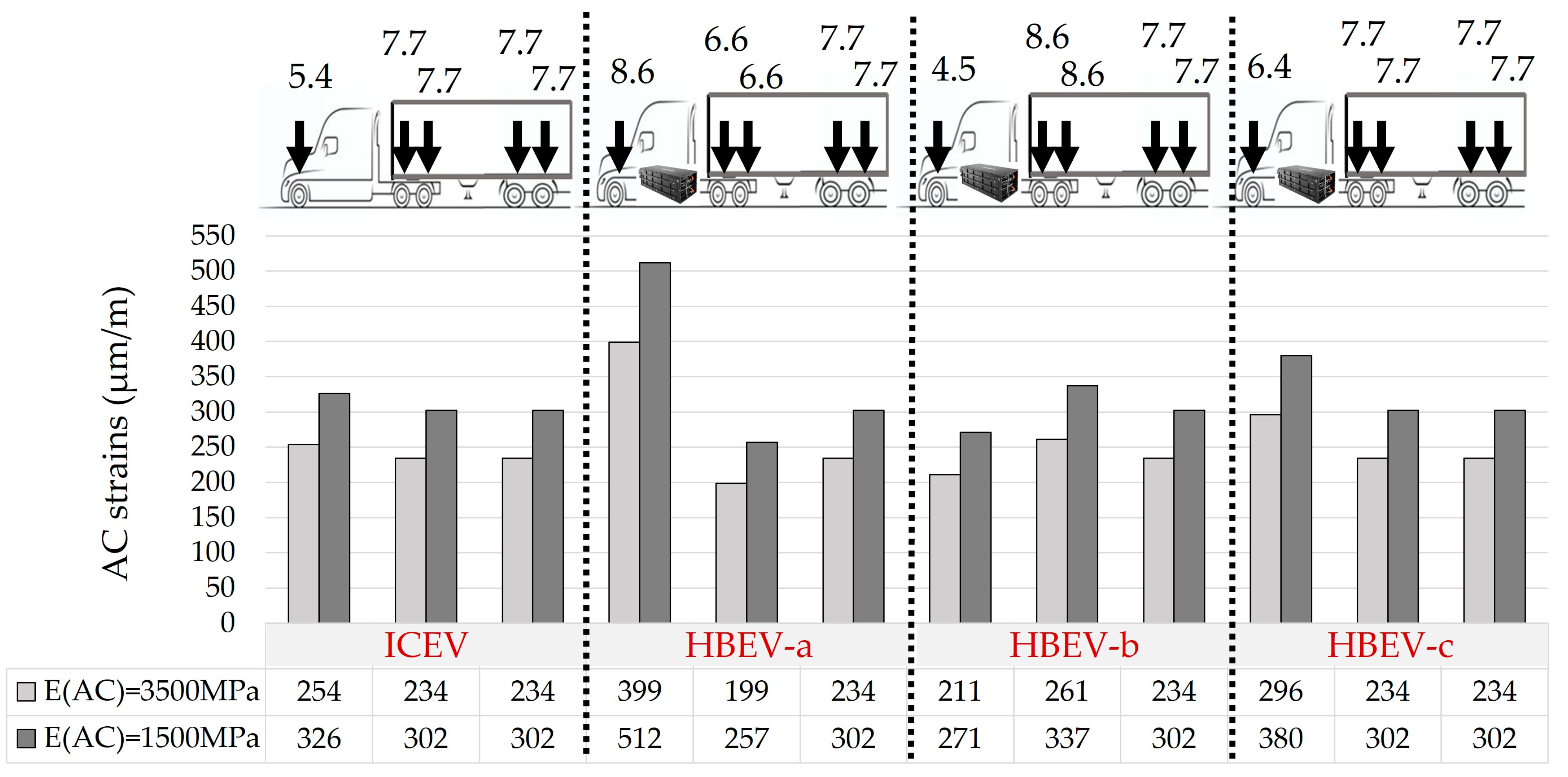
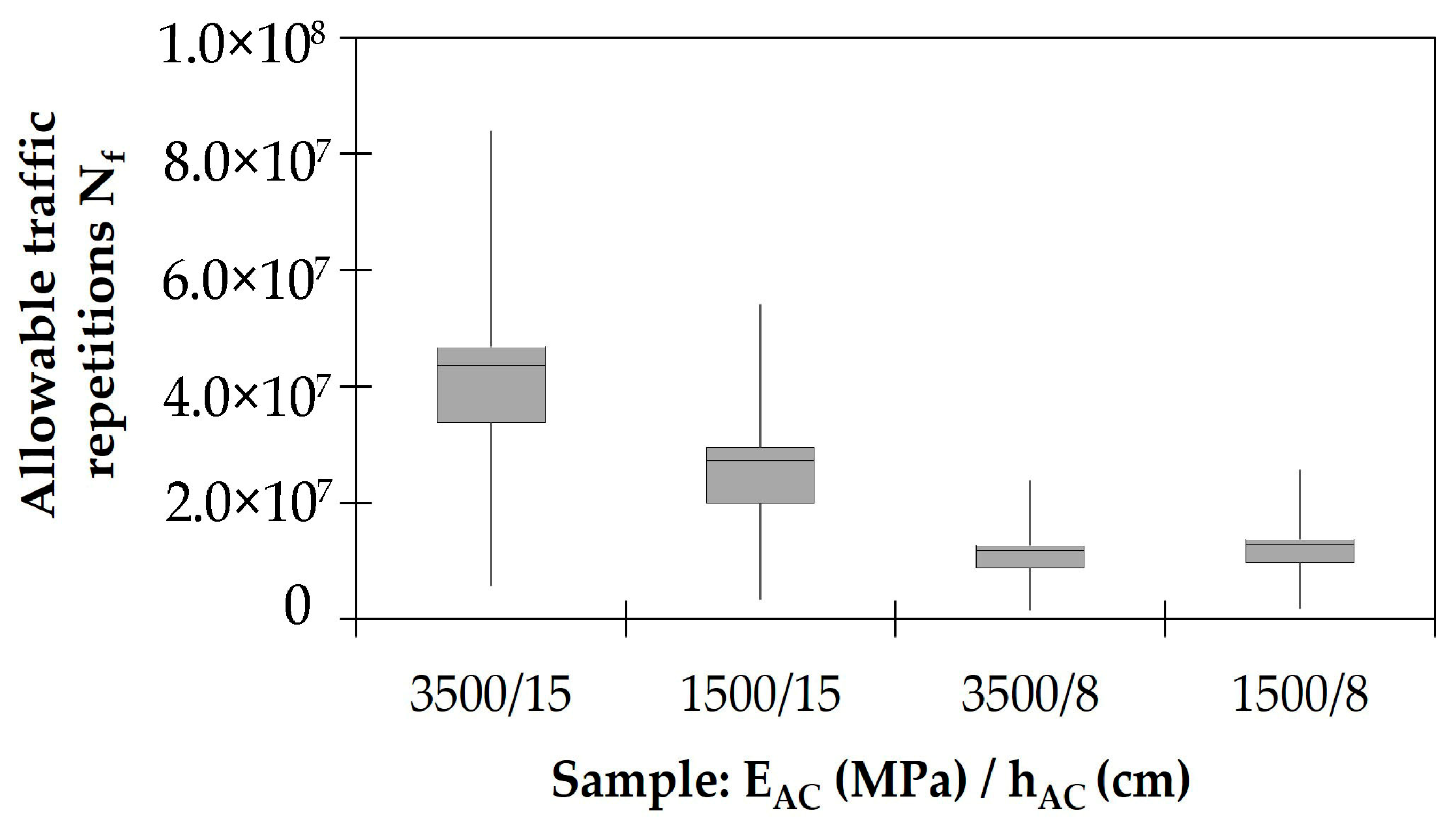
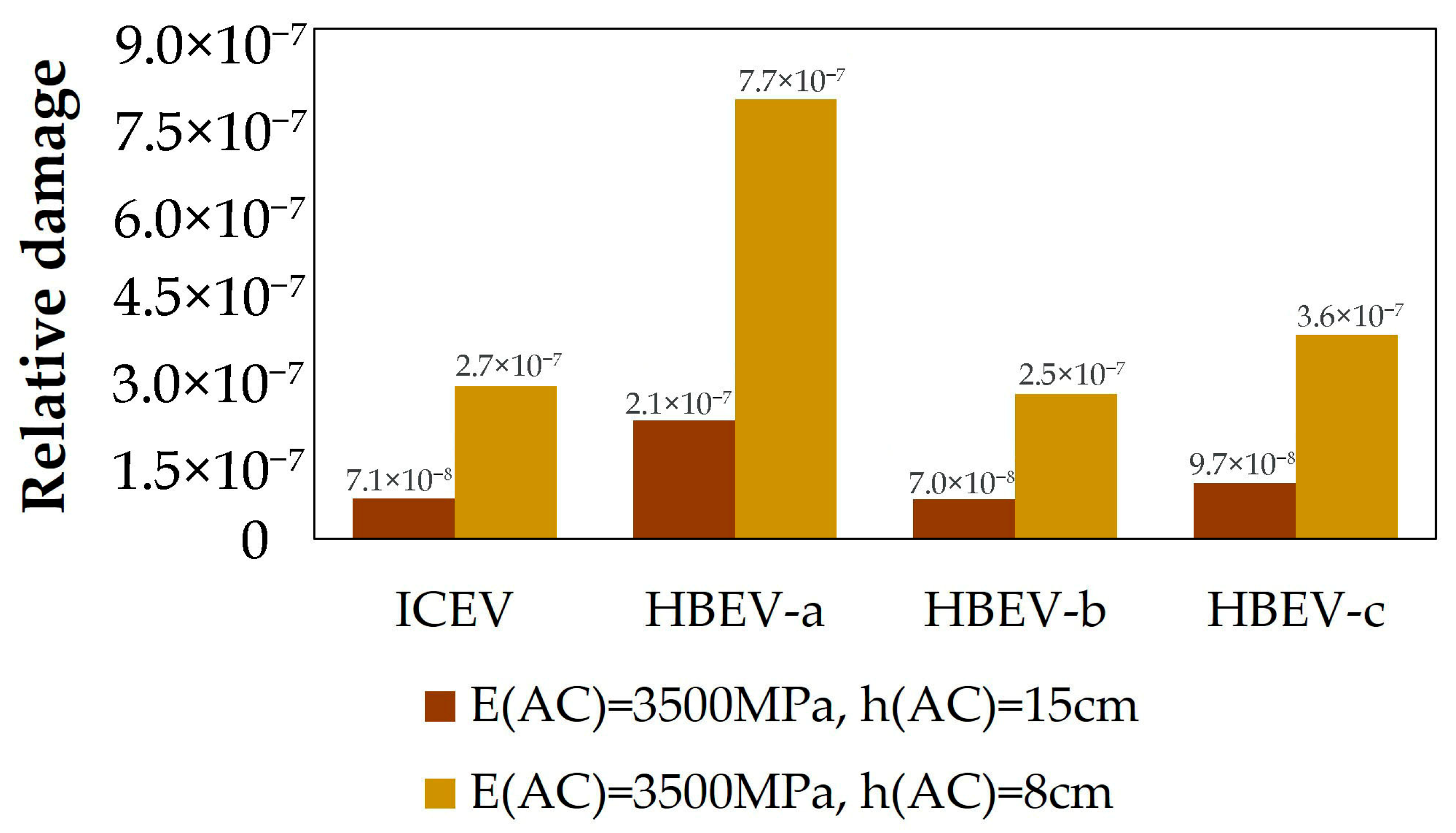

| Layer | CBR (%) | Elastic Modulus (MPa) |
|---|---|---|
| Base | 85 | 300 |
| Subgrade | 11 | 80 |
| Axle Configuration | Axle Load (tons) | Tire Load (tons) | Tire Radius (mm) | Tire Pressure (kPa) |
|---|---|---|---|---|
| Single axle, single tire | 5.44 | 2.72 | 117 | 637 |
| Single axle, single tire | 8.62 | 4.31 | 117 | 999 |
| Single axle, single tire | 4.54 | 2.27 | 117 | 530 |
| Single axle, single tire | 6.35 | 3.18 | 117 | 743 |
| Tandem axle, dual tires | 7.71 | 1.93 | 101 | 597 |
| Tandem axle, dual tires | 6.58 | 1.64 | 101 | 509 |
| Tandem axle, dual tires | 8.62 | 2.15 | 101 | 667 |
| Statistics | Variable 1 (Strains at AC Modulus of 3500 MPa) | Variable 2 (Strains at AC Modulus of 1500 MPa) | Result (ACCEPT OR REJECT) |
|---|---|---|---|
| Mean | 200.37 | 272.95 | |
| Variance | 4539.11 | 5971.51 | |
| Observations | 24 | 24 | |
| Pearson correlation | 0.987 | ||
| Hypothesized mean difference | 0 | ||
| df | 23 | ||
| tSTAT | −23.415 | REJECT | |
| P (T ≤ t) one-tailed | 7.57 × 10−18 | ||
| tCRIT one-tailed | 1.713 | ||
| P (T ≤ t) two-tailed | 1.515 × 10−17 | ||
| tCRIT two-tailed | 2.068 |
| Section | HBEV-a vs. ICEV | HBEV-b vs. ICEV | HBEV-c vs. ICEV |
|---|---|---|---|
| EAC = 3500 MPa; hAC = 15 cm | +194% | −1% | +37% |
| EAC = 1500 MPa; hAC = 15 cm | +201% | −5% | +37% |
| EAC = 3500 MPa; hAC = 8 cm | +188% | −5% | +34% |
| EAC = 1500 MPa; hAC = 8 cm | +185% | −5% | +34% |
Disclaimer/Publisher’s Note: The statements, opinions and data contained in all publications are solely those of the individual author(s) and contributor(s) and not of MDPI and/or the editor(s). MDPI and/or the editor(s) disclaim responsibility for any injury to people or property resulting from any ideas, methods, instructions or products referred to in the content. |
© 2025 by the author. Published by MDPI on behalf of the World Electric Vehicle Association. Licensee MDPI, Basel, Switzerland. This article is an open access article distributed under the terms and conditions of the Creative Commons Attribution (CC BY) license (https://creativecommons.org/licenses/by/4.0/).
Share and Cite
Gkyrtis, K. The Impact of Weight Distribution in Heavy Battery Electric Vehicles on Pavement Performance: A Preliminary Study. World Electr. Veh. J. 2025, 16, 520. https://doi.org/10.3390/wevj16090520
Gkyrtis K. The Impact of Weight Distribution in Heavy Battery Electric Vehicles on Pavement Performance: A Preliminary Study. World Electric Vehicle Journal. 2025; 16(9):520. https://doi.org/10.3390/wevj16090520
Chicago/Turabian StyleGkyrtis, Konstantinos. 2025. "The Impact of Weight Distribution in Heavy Battery Electric Vehicles on Pavement Performance: A Preliminary Study" World Electric Vehicle Journal 16, no. 9: 520. https://doi.org/10.3390/wevj16090520
APA StyleGkyrtis, K. (2025). The Impact of Weight Distribution in Heavy Battery Electric Vehicles on Pavement Performance: A Preliminary Study. World Electric Vehicle Journal, 16(9), 520. https://doi.org/10.3390/wevj16090520






